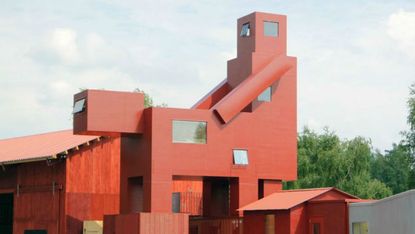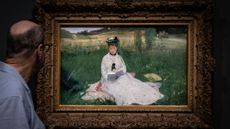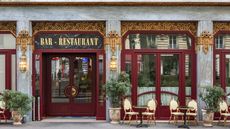Louvre ditches 'bestiality' sculpture deemed too explicit
The Domestikator, which appears to show a human having sex with a four-legged creature, has found a home at the Pompidou Centre

A 12-metre tall sculpture depicting a human figure appearing to penetrate an animal figure was determined to be too sexually explicit to be featured in the Louvre Museum in Paris.
Jean-Luc Martinez, the director of the world’s most popular museum, said the work “had a brutal aspect” in a letter to organisers of the International Contemporary Art Fair (FIAC), The Local reported.
Originally, the museum planned to house the sculpture, called the Domestikator, in the Tuileries Gardens next to the museum as part of the FIAC, but they ultimately decided against the idea.
Subscribe to The Week
Escape your echo chamber. Get the facts behind the news, plus analysis from multiple perspectives.

Sign up for The Week's Free Newsletters
From our morning news briefing to a weekly Good News Newsletter, get the best of The Week delivered directly to your inbox.
From our morning news briefing to a weekly Good News Newsletter, get the best of The Week delivered directly to your inbox.
“It risks being misunderstood by the visitors to the gardens,” Martinez said.
The Domestikator will now be housed at the Pompidou Centre after the centre decided the world should see the piece.
The sculpture was created by Dutch artist Joep van Lieshout, who was disappointed that the Louvre changed its mind. He told Reuters TV that he never meant for the artwork to be interpreted in a sexual way.
“I was surprised first of all, and then of course disappointed, because it [the Louvre] couldn’t show the art work,” he said. “I couldn’t explain my ideas to (the) larger public.”
Van Lieshout claims that his work was only meant to highlight the ethical issues surrounding the domestication of animals by humans for uses of agriculture and industry.
His steel, wood and fiberglass artwork still lives at the Pompidou Centre, where Bernard Blistene, director of the Pompidou Centre Museum, doesn’t see the obscenity most others saw in the piece.
“Obscene, pornographic? Well, obscenity is everywhere, pornography, sadly, is everywhere, certainly not in this work of art,” Blistene told Reuters.
“This work of art is funny, it is an obvious nod to the relationship of abstraction and figurative painting that co-exist in Dutch art in the 20th century. Spiritual yes, obscene no.”
The piece has already been displayed in Germany for three years where it hadn’t caused controversy.
The Louvre made the decision not to display the piece after seeing cynical comments about it on social media.
Others thought the Louvre was making a mistake and encroaching upon the artist’s freedom of expression.
In 2014, the FIAC was also involved in another artistic scandal in Paris. Vandals attacked a green inflatable sculpture in one of the capital’s squares after its resemblance to a sex toy caused uproar.
Paris mayor Anne Hidalgo labeled the 2014 incident an “unacceptable attack on artistic freedom”, says The Guardian.
Create an account with the same email registered to your subscription to unlock access.
Sign up for Today's Best Articles in your inbox
A free daily email with the biggest news stories of the day – and the best features from TheWeek.com
-
 UAW scores historic win in South at VW plant
UAW scores historic win in South at VW plantSpeed Read Volkswagen workers in Tennessee have voted to join the United Auto Workers union
By Peter Weber, The Week US Published
-
 Today's political cartoons - April 22, 2024
Today's political cartoons - April 22, 2024Cartoons Monday's cartoons - dystopian laughs, WNBA salaries, and more
By The Week US Published
-
 Ukraine cheers House approval of military aid
Ukraine cheers House approval of military aidSpeed Read Following a lengthy struggle, the House has approved $95 billion in aid for Ukraine and Israel
By Peter Weber, The Week US Published
-
 The birth of impressionism
The birth of impressionismThe Explainer Now iconic, the style of art characterised by airy colors and undefined brushstrokes was criticised in its early days
By The Week UK Published
-
 Take a Champagne-drinking tour across the globe
Take a Champagne-drinking tour across the globeThe Week Recommends Pop off at one of these seven Champagne-centric bars
By Catherine Garcia, The Week US Published
-
 A tour of Alain Ducasse’s chocolate factory in Paris
A tour of Alain Ducasse’s chocolate factory in ParisUnder the Radar Star chef has spent a decade transforming chocolate – now it’s coffee, ice cream and biscuits
By Jo Davey Published
-
 Restaurant Rochechouart review: a quintessential Parisienne lunch
Restaurant Rochechouart review: a quintessential Parisienne lunchThe Week Recommends If you’re visiting Paris don’t miss Hôtel Rochechouart’s restaurant and rooftop bar
By Felicity Capon Published
-
 A weekend in Paris: travel guide, attractions and things to do
A weekend in Paris: travel guide, attractions and things to doThe Week Recommends Plan the perfect 48 hours in the French capital, from hotels to restaurants
By Amrita Gill Published
-
 Maison Albar Hotels Le Vendome review: discover Paris’ hidden gems from a perfect base
Maison Albar Hotels Le Vendome review: discover Paris’ hidden gems from a perfect baseThe Week Recommends Five-star hotel is located steps away from the Opéra Garnier and Place Vendôme
By Nick Hendry Published
-
 Hotel Villa Marquis review: setting the scene for a playful stay in Paris
Hotel Villa Marquis review: setting the scene for a playful stay in ParisThe Week Recommends Mere moments from the Eiffel Tower, this recently renovated property hits all the right rom-com notes
By Julia O'Driscoll Published
-
 Hotel Maison Colbert review: an elegant Parisian palace with iconic views
Hotel Maison Colbert review: an elegant Parisian palace with iconic viewsThe Week Recommends This Meliá Collection hotel is an artistic haven in the heart of the French capital
By Julia O'Driscoll Published